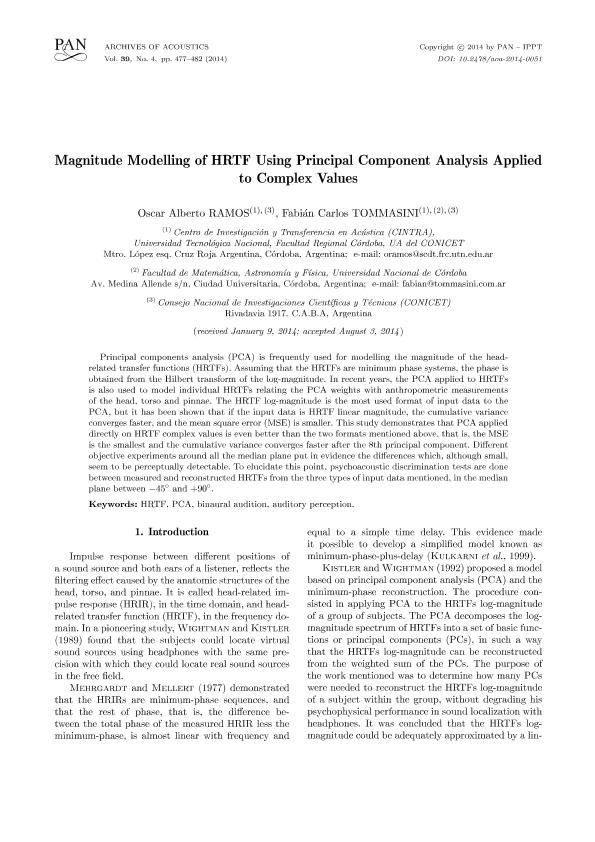Mostrar el registro sencillo del ítem
dc.contributor.author
Ramos, Oscar Alberto

dc.contributor.author
Tommasini, Fabián Carlos

dc.date.available
2022-12-07T17:56:12Z
dc.date.issued
2014-12
dc.identifier.citation
Ramos, Oscar Alberto; Tommasini, Fabián Carlos; Magnitude modelling of HRTF using principal component analysis applied to complex values; Polish Acad Sciences Inst Fundamental Technological Research; Archives Of Acoustics; 39; 4; 12-2014; 477-482
dc.identifier.issn
0137-5075
dc.identifier.uri
http://hdl.handle.net/11336/180599
dc.description.abstract
Principal components analysis (PCA) is frequently used for modelling the magnitude of the headrelated transfer functions (HRTFs). Assuming that the HRTFs are minimum phase systems, the phase is obtained from the Hilbert transform of the log-magnitude. In recent years, the PCA applied to HRTFs is also used to model individual HRTFs relating the PCA weights with anthropometric measurements of the head, torso and pinnae. The HRTF log-magnitude is the most used format of input data to the PCA, but it has been shown that if the input data is HRTF linear magnitude, the cumulative variance converges faster, and the mean square error (MSE) is smaller. This study demonstrates that PCA applied directly on HRTF complex values is even better than the two formats mentioned above, that is, the MSE is the smallest and the cumulative variance converges faster after the 8th principal component. Different objective experiments around all the median plane put in evidence the differences which, although small, seem to be perceptually detectable. To elucidate this point, psychoacoustic discrimination tests are done between measured and reconstructed HRTFs from the three types of input data mentioned, in the median plane between −45◦ and +90◦ .
dc.format
application/pdf
dc.language.iso
eng
dc.publisher
Polish Acad Sciences Inst Fundamental Technological Research

dc.rights
info:eu-repo/semantics/openAccess
dc.rights.uri
https://creativecommons.org/licenses/by-nc-sa/2.5/ar/
dc.subject
HRTF
dc.subject
PCA
dc.subject
BINAURAL AUDITION
dc.subject
AUDITORY AUDITION
dc.subject.classification
Óptica

dc.subject.classification
Ciencias Físicas

dc.subject.classification
CIENCIAS NATURALES Y EXACTAS

dc.subject.classification
Otras Ingenierías y Tecnologías

dc.subject.classification
Otras Ingenierías y Tecnologías

dc.subject.classification
INGENIERÍAS Y TECNOLOGÍAS

dc.title
Magnitude modelling of HRTF using principal component analysis applied to complex values
dc.type
info:eu-repo/semantics/article
dc.type
info:ar-repo/semantics/artículo
dc.type
info:eu-repo/semantics/publishedVersion
dc.date.updated
2022-12-06T17:11:15Z
dc.journal.volume
39
dc.journal.number
4
dc.journal.pagination
477-482
dc.journal.pais
Polonia

dc.journal.ciudad
Warszawa
dc.description.fil
Fil: Ramos, Oscar Alberto. Consejo Nacional de Investigaciones Científicas y Técnicas; Argentina. Centro de Investigación y Transferencia en Acústica; Argentina
dc.description.fil
Fil: Tommasini, Fabián Carlos. Centro de Investigación y Transferencia en Acústica; Argentina. Universidad Nacional de Córdoba. Facultad de Matemática, Astronomía y Física; Argentina
dc.journal.title
Archives Of Acoustics

dc.relation.alternativeid
info:eu-repo/semantics/altIdentifier/doi/http://dx.doi.org/10.2478/aoa-2014-0051
dc.relation.alternativeid
info:eu-repo/semantics/altIdentifier/url/https://journals.pan.pl/aoa/116743
dc.relation.alternativeid
info:eu-repo/semantics/altIdentifier/url/https://acoustics.ippt.pan.pl/index.php/aa/article/view/294
Archivos asociados
